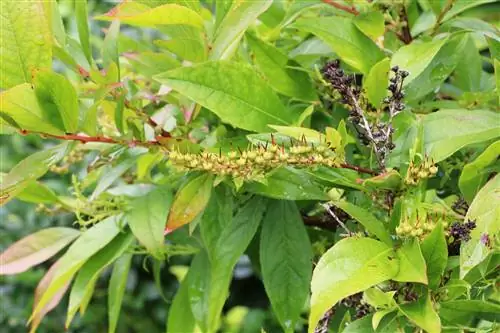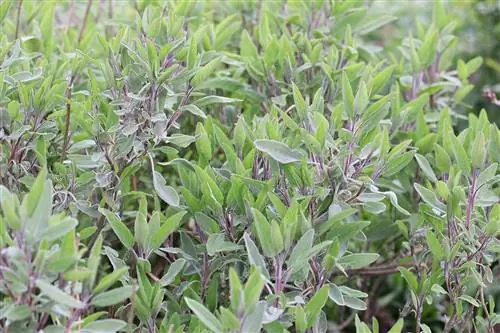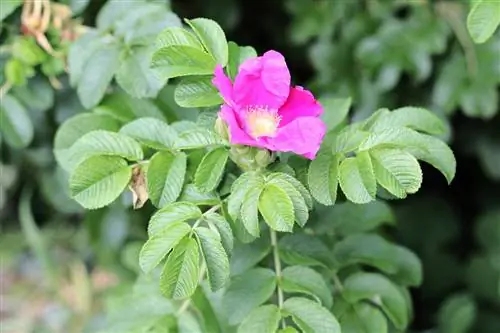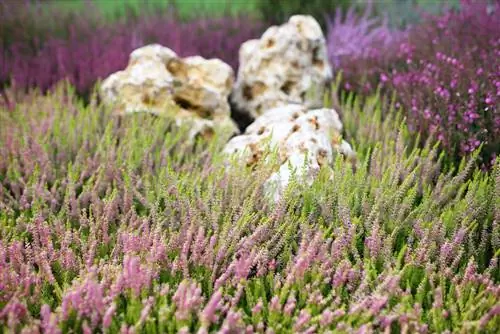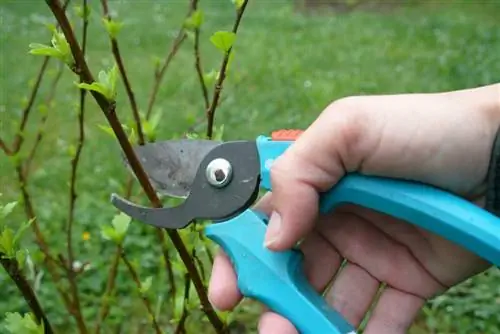- Author admin [email protected].
- Public 2023-12-17 03:39.
- Last modified 2025-06-01 06:48.
The grape heather, whose botanical name is leucothoe, is less well known than its colorful family members bell heather or broom heather. The white-flowering shrub is a popular spring bloomer that is particularly popular as an evergreen ground cover. Caring for this plant, also known as grape myrtle, is easy and does not require much effort.
Grape heather - an evergreen ericaceous plant
Grape heather is one of the ericaceous plants. Location and care must be tailored to the special needs of this species. Basically, the heather needs the same conditions as rhododendrons in order to develop their flowers and decorative foliage. The more light the plants receive, the more beautifully they bloom and the brighter the leaf colors appear. Anyone who plants grape heather primarily for decorative purposes should therefore ensure that it is in a bright location, although it should not be in the blazing sun. But grape heather also thrives under large bushes in partial shade, where it serves as a ground cover and prevents weeds from emerging.
Grape heather is often found on graves as it grows quickly and spreads over the grave. Other options for caring for grape heather include buckets and pots for the balcony or terrace. Together with blooming summer flowers, the colored leaves create decorative plays of color.
Using the evergreen plant as
- Ground cover plants on garden beds
- Grave planting
- Decoration on the terrace or balcony
Traubenheide: Protected location preferred
When choosing the location, it must be taken into account that grape heather is only moderately winter-hardy. If temperatures are too low, there is a risk of freezing. The location should therefore be somewhat protected and can be provided with winter protection if necessary. In preparation for planting in the perennial bed or on the edges of the bed, the soil is loosened slightly. Since the grape heather only has shallow roots, deep loosening is not necessary; 15 centimeters is sufficient. The soil should be lime-free and slightly acidic. Potting soil for rhododendrons is ideal for supplying grape heather. The plants are placed approximately 40 centimeters apart and the roots are well covered with soil.
Mulching instead of fertilizing
Grape heather does not tolerate drought well. Regular watering with lime-free water, preferably from a rain barrel, is therefore absolutely necessary. To keep the soil moist, it is recommended to mulch the soil with bark mulch. This means that the moisture in the soil is retained and watering does not have to be done as often, even on hot summer days. Experienced hobby gardeners recommend disposing of apple peels and other acidic fruit and vegetable residues that arise in the kitchen between the grape heather bushes. This gives the soil additional acidity. Peat is also very suitable for soil improvement.
Fertilizer is usually not necessary. It only makes sense to add fertilizer to rhododendrons or ericaceous plants if the plants are taking care of them. However, with a good layer of mulch, it is almost never necessary to add additional fertilizer. A light windbreak can help if the grape heather grows only sparsely.
- partially shaded, bright location
- acid soil
- mulching with bark mulch or peat
- fertilizing with fertilizer for rhododendrons
- watering regularly
- cut or shorten if necessary
- Provide wind protection
- Cut only when necessary
Traubenheide requires little care other than regular watering. If the plants become too dense and too large, individual shoots can be cut out throughout the gardening year. General shortening of the plants is also possible, but it is not necessary. Cutting should only be done with caution so that the splendor of the leaves' color is preserved. Since grape heather spreads itself through runners, it may be necessary to remove individual plants or shoots.
In general, however, this ground-covering spread in the garden or on the grave is definitely desirable. Only if the plants grow too much should they be thinned out. In unprotected locations or in very cold winter temperatures, frost protection made of straw or coniferous branches prevents the plants from freezing. Grape heather is almost never attacked by pests and therefore does not need any special protection.
Grape heather for the terrace
Grape heather is also suitable as a decorative foliage plant for pots and balcony boxes. It is often placed in groups with summer bloomers such as geraniums, petunias or climbing plants. With the right care, the plants can be kept on the balcony for several years. Acidic soil and watering with lime-free water promote growth. The pots or boxes must be overwintered in a cool but frost-free room with enough light. Overwintering outdoors in a bucket is not possible because the grape heather will freeze to death. In spring the soil should be renewed so that the heather receives enough nutrients.
Propagation by cuttings or seeds
The grape heather is propagated either by taking cuttings or by sowing seeds. Both options are easy to do. When propagating by cuttings, half-woody shoots that have already formed small roots are separated with a knife or scissors and placed in loose planting substrate. The best time for this is summer, as the cuttings then root and grow quickly. The seeds are scattered in seed soil in spring and watered carefully until the first plants appear. They are transplanted into small pots until they are large enough to be planted in the garden bed.
- Cut cuttings for propagation
- Or sow seeds
- Protect from frost in winter
What you should know about grape heath in brief
Grape heather is the ideal garden plant to cover the ground and thereby keep beds or graves free of weeds. The decorative appearance of the marbled or monochromatic, evergreen leaves ensures that they are very popular with hobby gardeners. With proper care, it will serve as an effective eye-catcher on beds, terraces or balconies for several years.
- The grape heather (Leucothoe) is also known as grape myrtle.
- It is evergreen, tolerates a lot of shade and brightens up even the darkest corner of the garden with its colorful foliage.
- The grape heather is a shallow-rooted plant. The plant sprouts runners and forms large, loose clumps.
- The grape heather originally grows as an understory in the forests of North America.
- The leaves are green-pink to reddish marbled, have yellow stripes and irregular spots.
- Often one side of the leaf is reddish and the other is bright pinkish yellow.
As the leaves get older, they lose their striking colors. They are then usually dark green with light green and yellowish marbling. Even in winter the plant makes a good impression. The entire foliage is covered in red. Light and dark colors create a wide variety of contrasts.
The growth of the grape heather is loose and broadly bushy. The plant can grow to a height of 25 to 30 cm and has dense shoots. The plant is well suited for planters, small gardens or even graves. It grows quickly but can be easily cut back or divided. Fragrant, white flower clusters form in May (hence the name). These form mainly at the ends of the shoots.
- The grape heather prefers humus-rich, fresh, slightly acidic soils.
- She loves shady places. The more light it gets, the more beautiful the color of the foliage is.
- So that the beautiful play of colors of the leaves stands out, the grape heather should always be planted in the foreground.
- When planted in groups, the great effect of the heather is enhanced.
- The plant also feels at home under trees as a subsoil plant.
- It is an excellent ericaceous bed and cemetery plant.
- The grape heather needs sufficient moisture.
- You can fertilize with slow-release fertilizer in spring.
- Propagation occurs through division. Since the plant sprouts runners, it reproduces on its own.

